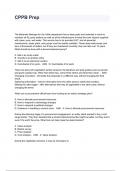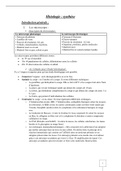Week 1: Introduction to operations management and process
analysis
Part 1: Introduction to operations management and processes
Consumer utility: a measure of the customer preference of a product or service. Consumer
utility is composed of the following 3 components: consumption utility, price, and
inconvenience.
Consumption utility is a measurement of how much you like a service, ignoring the effects of
price and its inconvenience. Consumption ability comes from various attributes such as
performance and fit.
Price is the total cost of owning a product or receiving a service. It includes expenses such as
shipping and financing.
Inconvenience is the reduction in utility that results from the effort of obtaining the product
or service. For example, sources of inconvenience can be location, and timing.
Strategic trade-off: when selecting inputs and resources, the firm must choose between a
set that excels in one direction of customer utility or another, but no single set of inputs and
resources can excel in all dimensions.
Capabilities: the dimensions of the customer’s utility function a firm is able to satisfy.
Capabilities allow a company to do well on some but not all components of customer utility.
Companies develop a balance on the responsiveness and cost performance trade-off.
Market segments: a set of customers who have similar utility functions.
The efficient frontier consists of the firms that are not dominated by other firms on a
dimension 1 and 2 comparison graph.
Operations management is all about improving the way a business does its work in order to
be part of the efficient frontier. Managing processes to efficiently (reduced cost, better
utilized resources) match demand and supply.
Costs for inputs: inputs are the things that a business purchases. Costs for resources:
resources are the things in a business that help transform input into output that match
customers demand.
Inefficiencies can be caused by three system inhibitors: waste, variability and inflexibility.
Waste is the consumption of inputs and resources that do not add value to the customer.
Variability is predictable or unpredictable changes in demand or the supply process.
Inflexibility is the inability to adjust to either changes in the supply process or changes in the
customer demand.
, A process is a set of activities that take a collection of inputs, perform some work or
activities with those inputs by means of resources, and then yield a set of outputs.
Process flow diagram: a graphical way to describe the process. It used boxes to depict
resources, arrows to depict flows, and triangles to depict inventory location.
Resource: a collection of equipment/people that can perform an identical set of activities.
A flow unit is the basic unit that moves through the process. Choose the flow unit that
corresponds to what you want to track and measure. Stick with the flow unit that you define
throughout the whole process.
The key questions when looking at a process are:
- Is the process performing well?
- How can we make the process better?
Process metric: something that we can measure that informs us about the performance and
capability of a process. There are 3 key process metrics:
- Inventory (I): the number of units within a process. Inventory tells us how much
“stuff” is in the process. Inventory takes up space and costs money, and is expressed
in units.
- Flow rate (R): the rate at which flow units travel through a process, which is
expressed in units/times units.
- Flow time (T): the time a flow unit spends in a process, from start to finish, which is
expressed in time units.
Little’s law: the law that describes the relationship between three key process metrics:
I =R ∙T
If you know (or observe) any of the two key process metrics, you can use Little’s Law to
derive the third.
Part 2: Process analysis
The first step of any analysis of an operation is drawing a process flow diagram.
In a one-step process, one resource is performing all activities. A resource I is comprised of
m ≥ 1 resource units.
Flow rate (or throughput) (R): the rate at which flow units travel through a process.
Process capacity (C): determines how many flow units can be processed per unit of time. It
determines the maximum flow rate a process can provide per unit of time, and thus the
maximum supply of the process (in units/time unit).
Processing time (ti): the time it takes a resource unit (of resource i) to complete one unit
flow (in time units).
analysis
Part 1: Introduction to operations management and processes
Consumer utility: a measure of the customer preference of a product or service. Consumer
utility is composed of the following 3 components: consumption utility, price, and
inconvenience.
Consumption utility is a measurement of how much you like a service, ignoring the effects of
price and its inconvenience. Consumption ability comes from various attributes such as
performance and fit.
Price is the total cost of owning a product or receiving a service. It includes expenses such as
shipping and financing.
Inconvenience is the reduction in utility that results from the effort of obtaining the product
or service. For example, sources of inconvenience can be location, and timing.
Strategic trade-off: when selecting inputs and resources, the firm must choose between a
set that excels in one direction of customer utility or another, but no single set of inputs and
resources can excel in all dimensions.
Capabilities: the dimensions of the customer’s utility function a firm is able to satisfy.
Capabilities allow a company to do well on some but not all components of customer utility.
Companies develop a balance on the responsiveness and cost performance trade-off.
Market segments: a set of customers who have similar utility functions.
The efficient frontier consists of the firms that are not dominated by other firms on a
dimension 1 and 2 comparison graph.
Operations management is all about improving the way a business does its work in order to
be part of the efficient frontier. Managing processes to efficiently (reduced cost, better
utilized resources) match demand and supply.
Costs for inputs: inputs are the things that a business purchases. Costs for resources:
resources are the things in a business that help transform input into output that match
customers demand.
Inefficiencies can be caused by three system inhibitors: waste, variability and inflexibility.
Waste is the consumption of inputs and resources that do not add value to the customer.
Variability is predictable or unpredictable changes in demand or the supply process.
Inflexibility is the inability to adjust to either changes in the supply process or changes in the
customer demand.
, A process is a set of activities that take a collection of inputs, perform some work or
activities with those inputs by means of resources, and then yield a set of outputs.
Process flow diagram: a graphical way to describe the process. It used boxes to depict
resources, arrows to depict flows, and triangles to depict inventory location.
Resource: a collection of equipment/people that can perform an identical set of activities.
A flow unit is the basic unit that moves through the process. Choose the flow unit that
corresponds to what you want to track and measure. Stick with the flow unit that you define
throughout the whole process.
The key questions when looking at a process are:
- Is the process performing well?
- How can we make the process better?
Process metric: something that we can measure that informs us about the performance and
capability of a process. There are 3 key process metrics:
- Inventory (I): the number of units within a process. Inventory tells us how much
“stuff” is in the process. Inventory takes up space and costs money, and is expressed
in units.
- Flow rate (R): the rate at which flow units travel through a process, which is
expressed in units/times units.
- Flow time (T): the time a flow unit spends in a process, from start to finish, which is
expressed in time units.
Little’s law: the law that describes the relationship between three key process metrics:
I =R ∙T
If you know (or observe) any of the two key process metrics, you can use Little’s Law to
derive the third.
Part 2: Process analysis
The first step of any analysis of an operation is drawing a process flow diagram.
In a one-step process, one resource is performing all activities. A resource I is comprised of
m ≥ 1 resource units.
Flow rate (or throughput) (R): the rate at which flow units travel through a process.
Process capacity (C): determines how many flow units can be processed per unit of time. It
determines the maximum flow rate a process can provide per unit of time, and thus the
maximum supply of the process (in units/time unit).
Processing time (ti): the time it takes a resource unit (of resource i) to complete one unit
flow (in time units).










